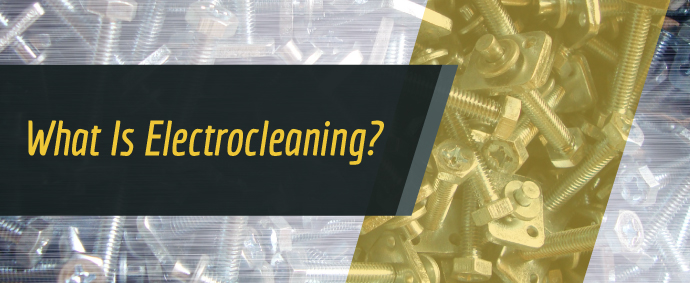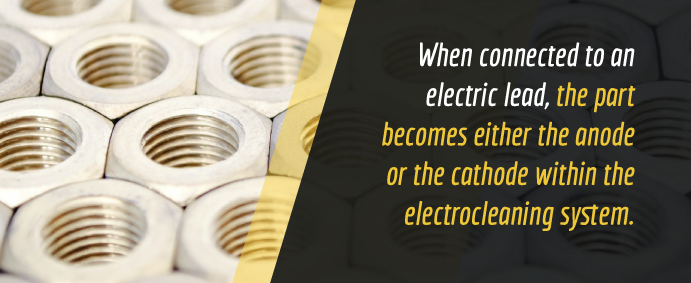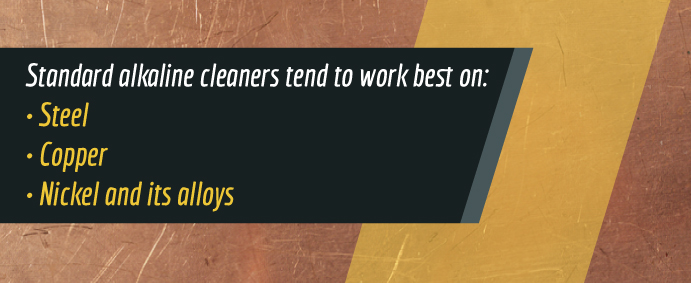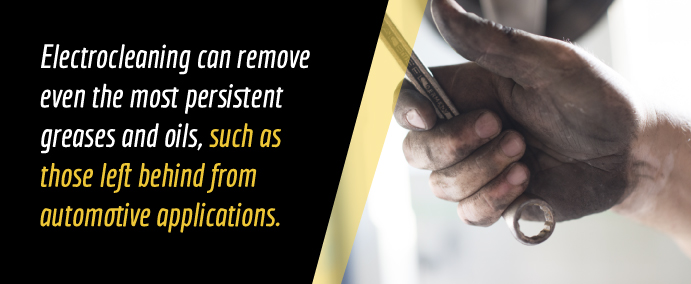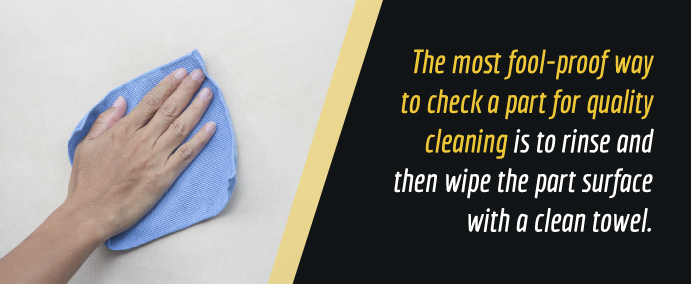You may be quite familiar with electroplating and all the benefits this plating method offers. However, most people don’t know exactly what goes into the electroplating process, especially the early steps.
One of the first steps of the electroplating process, in fact, is preparing the surface. This process of preparation is used as a way to enhance the surface for plating, removing any defects or contaminants to help ensure the best quality plating possible. One common way of doing this is through a cleaning process called electrocleaning.
What Is Electrocleaning?
Also known as electrolytic cleaning, “electrocleaning” is a popular cleaning choice for numerous applications, and it is commonly used as a preparatory step for metal parts before they undergo electroplating. This cleaning method involves introducing a controlled electric current to an electrolytic bath full of cleaning solution, which results in a vigorous cleaning of any parts immersed in the bath.
The resulting electrochemical scrub is used to remove soil, grease and corrosive elements from any surface, no matter how deep-set.
What Is the Electrocleaning System?
The electrocleaning system closely resembles the system used in an electroplating setup, but it is altered slightly to accomplish a cleaning purpose, rather than a plating one. Like electroplating, an electrolytic bath and the workpiece are hooked up to a controlled circuit, but instead of the bath containing dissolved particles of metal or coating chemicals, the bath contains cleaning solution.
The specifics of the system, however, still vary depending on the specifics of the workpiece. The best electrocleaning results come when the system is optimized for the specific part. This includes choosing the best cleaning solution, system and process for the material involved.
The electrocleaning system consists of the following components:
- The Part: The part to be cleaned plays one of two roles within the electrocleaning system. When connected to an electric lead, the part becomes either the anode or the cathode within the electrocleaning system. The material of this part will determine the role it plays, as well as the other components of the system.
- The Cleaning Solution: The solution in which the part is submerged varies, largely depending on the material of the part, the desired results of the process or the electrocleaning process itself. An improper solution for a particular material could result in oxidation, embrittlement or other surface imperfections. The wrong solution can also cause the material’s surface to become chemically inert, preventing proper electroplating in the future.
As soon as all of these parts are added to the system, an electric current is run through it. This results in an electrochemical reaction, which appears visibly as bubbles forming on the workpiece surface. These bubbles form directly on the surface of the workpiece, underneath any contaminants or films, causing the contaminant to lift from the surface of the material.
What Are the Different Kinds of Electrocleaning Systems?
The workpiece can play one of two roles within the electrocleaning system. Which of the two roles the part plays in the system is determined primarily by the type of electrocleaning process used. There are two primary varieties of electrocleaning: anodic and cathodic. The attributes of anodic vs. cathodic cleaning are as follows:
Anodic Electrocleaning: In this variation of the electrocleaning process, the workpiece becomes the anode within a reverse-current system submerged in a basic solution. Both factors facilitate an oxidation reaction, producing bubbles of oxygen gas. These gas bubbles form directly on the workpiece, helping to remove any contaminants. This method is preferable for ferrous materials, as these materials tend to fare better in basic solutions.
Anodic electrocleaning systems typically use alkaline, or basic, cleaners, which are separated into standard and inhibited alkaline cleaners. Standard alkaline cleaners tend to work best on:
Inhibited alkaline cleaners are most effective on:
- Brass
- Bronze
- Zinc and its alloys
- Tin
- Aluminum and its alloys
Cathodic Electrocleaning: Instead of making the workpiece the anode, cathodic electrocleaning makes the workpiece the cathode within a direct-current system. Additionally, this system differs from the anodic system by using an acidic cleaning solution instead of an alkaline solution. These factors facilitate the formation of hydrogen gas bubbles at the surface of the workpiece, helping to lift contaminants from the surface. Though more powerful overall, producing twice as much hydrogen gas as oxygen gas in the anodic process, the direct current in this system often results in metallic films depositing on the workpiece, resulting in rougher, less-perfect surfaces. This system tends to be the best choice for magnesium workpieces, among other materials.
Overall, anodic cleaning tends to be the most preferable of the two cleaning methods, and it is applied to the widest variety of applications. This is because anodic electrocleaning dissolves the work surface as it cleans, removing any metallic coatings and films that could interfere with plating later on. Anodic electrocleaning also uses a reverse current, which effectively pushes materials away from the workpiece’s surface.
Cathodic electrocleaning, on the other hand, though it produces more bubbles, tends to be the less preferable of these two methods, primarily due to the imperfections that can arise from the process. Because of the direct current used in the system, the current moves toward the part, attracting metallic debris. This can cause metallic films to deposit on the work surface, resulting in a less perfect surface for electroplating.
However, you cannot consider the pros and cons of these methods by themselves — the material of the workpiece should also be taken into consideration when choosing an electrocleaning method. For example, materials like aluminum, chromium, tin, lead, brass, magnesium or any alkaline-soluble metals tend to dissolve quickly in anodic systems. For this reason, alternative cleaning methods are preferable for these types of materials.
Because of the various drawbacks associated with both pure anodic and pure cathodic electrocleaning methods, additional variations on these methods have been developed. These variations include the following:
- Periodic-Reverse (PR) Cleaning: Periodic-reverse cleaning essentially alternates between an anodic and cathodic electrocleaning system, alternating the workpiece’s role between anode and cathode. The piece continues cycling through the role until the process is completed, at which point it is taken out of the solution during the anodic part of the cycle. The process is typically completed in an alkaline solution, though the solution contains additional agents to help remove contaminants such as smut and scale. This system tends to work better than either pure anodic and pure cathodic processes for certain workpieces, as it combines the alkaline environment of an anodic system with the vigor of a cathodic system. Additionally, this system eliminates the possibility of over-etching, which usually happens when acid is trapped in the nooks and crannies of workpieces, removing more material than intended.
- Interrupted-Current (IR) Cleaning: Commonly used in electropolishing and electroforming processes, interrupted-current cleaning addresses the issue of cleaning solution concentrations at the surface of the workpiece. Essentially, as the cleaning solution reacts at the surface of a workpiece, the amount of cleaning solution reduces over time, making it harder for the reaction to occur again. Interrupted-current cleaning solves this issue by regularly turning off the system to allow the cleaning solution to redistribute, restoring the concentration of the cleaning solution at the surface of the workpiece. This cycle normally involves eight to nine seconds of applied current, followed by one or two seconds with the current turned off.
How Is Electrocleaning Used?
Electrocleaning tends to work very well in removing a variety of contaminants and films. Just a few of these contaminants include:
- Oils: From industrial to organic variants, electrocleaning can remove even the most persistent greases and oils, such as those left behind from fingerprints, machining oils and automotive applications. Waxes and lubricants can also be removed with this method.
- Coatings: Paints, thin phosphate coatings and other finishes can easily be removed with a vigorous electrocleaning method.
- Imperfections: Hard-water scale, rust and tarnish all form with time and use. Electrocleaning can remove all such imperfections easily.
From cleaning parts in preparation for plating to removing imperfections from old or rusted parts, electrocleaning is an extremely useful cleaning method for a variety of applications. The method is even used as a de-rusting method for antique metal parts, though it’s more often used in preparation for plating newer workpieces.
What Are the Advantages of Electrocleaning?
Electrocleaning poses several unique advantages over other cleaning methods, including the following:
- Extremely Thorough: For iron pieces, anodic electrocleaning poses an extremely thorough alternative to other cleaning methods. Not only does the method lift all contaminants easily, but it minimizes damage to the workpiece, which is an especially important factor when working with antiques and re-finishing projects.
- Effective for Various Contaminants: No matter the contaminant, whether it is an organic wax, an inorganic grease or a natural buildup of rust or tarnish, electrocleaning can help remove any imperfection easily.
- Multiple Applications: Electrocleaning processes work well with both rack plating and barrel plating applications.
What Are the Disadvantages of Electrocleaning?
While electrocleaning poses several unique advantages over other cleaning methods, the process still possesses several drawbacks, mostly having to do with the process itself and its compatibility with certain materials. A few of these disadvantages include:
- Variable Results: When using a cathodic electrocleaning process, it is possible for a metallic film to form. This doesn’t happen consistently, but when it does, it can result in rough surfaces with poor adhesive properties, reducing the quality of the finish. This variability in results can pose a serious problem when attempting to achieve identical production results, as products cleaned with a cathodic electrocleaning process tend to require refinishing more often than those cleaned with anodic processes.
- Hydrogen Embrittlement: Cathodic electrocleaning can result in hydrogen embrittlement in certain cases, especially parts made of particularly hard materials. This embrittlement can be rectified with heat treatment, but failing to do this can result in poor-quality products.
- Material-Specific Considerations: Both anodic and cathodic electrocleaning processes can pose negative results for certain materials if proper alterations are not enacted. For example, zinc can be de-zincified or over etched in high-current, high-temperature environments. These problematic results can be avoided, however, with proper training and knowledge in electrocleaning methods.
How Do You Gauge Electrocleaning Success?
There are many ways you can gauge the effectiveness of your electrocleaning process on individual workpieces. Some of the easiest ways to ensure proper electrocleaning function include:
- Wiping the Surface: The simplest and most fool-proof way to check a part for quality cleaning is to rinse off and then wipe the part surface with a clean towel. Any remaining contaminants or imperfections can be found either by sight or by touch using this method.
- Rinsing the Surface: One of the easiest things to do to check for a quality electrocleaning product is rinsing the surface of the material. This allows finishers to look for water breaks on the surface of the part. These breaks usually indicate contaminated or otherwise imperfect surfaces.
- Post-Production Checks: Though not an ideal way to discover problems in the cleaning process, you can generally determine the cleanliness of a part by the quality of the part’s coating post-production. An improperly cleaned part will have coated areas that are flaky, rough or otherwise imperfect. Though a poor coating could also be the result of other unrelated factors, the most common reason for such poor finish quality is most often a failure during the cleaning process.
Imperfections in a cleaning job are best found before plating. It is much better to re-wash a part than to continue with the plating process and risk plating the part with a faulty finish. Imperfect coatings and platings tend to be very expensive in time and materials to fix, and they often result in scrapped material or parts.
Where Can You Find Electrocleaning Services?
Anodic electrocleaning services and cathodic electrocleaning services are often offered alongside electroplating services, as the two processes go hand-in-hand in providing a high-quality metal plating. Sharretts Plating Company is no exception.
With over 90 years of experience in the metal finishing industry, Sharretts Plating Company is one of the best industrial electrocleaning companies in the business. Even if electrocleaning and electroplating isn’t the way you want to go, SPC can help you find the best method for your project. With our consultative approach to plating, we can suggest and test a variety of plating options to help you pinpoint the process with the best results for your project’s needs, both practical and budgetary.
SPC has hundreds of years in combined experience in metal surface preparation services, and our professionals know how to plate just about anything, from metals to exotic materials like ceramics and plastics. Our consultative services can help evaluate your project and determine the best metal surface preparation techniques for your application. We offer several varieties of cleaning and coating services. From ultrasonic washing and abrasive blasting services to chem film coatings, SPC has the knowledge and capability to finish your products your way.
Contact SPC today to learn more about our industrial electrocleaning services and to receive a free, no-obligation quote.


